 Back in my college days, I played on a team with a guy called Peter Verouden. Peter was a decent player but he had 2 problems. First, he frequently managed to create an odd result by taking some anti-percentage play. Second, he never stopped talking about the hands. That is a dangerous combination, if he was wrong, he could easily spend the rest of the night explaining to one and all why he was right and he should be considered the unluckiest player in the universe because the distribution of the cards didn’t quite match his line of play. If he was right, well, then you’d hear about it until the cows came home.
Back in my college days, I played on a team with a guy called Peter Verouden. Peter was a decent player but he had 2 problems. First, he frequently managed to create an odd result by taking some anti-percentage play. Second, he never stopped talking about the hands. That is a dangerous combination, if he was wrong, he could easily spend the rest of the night explaining to one and all why he was right and he should be considered the unluckiest player in the universe because the distribution of the cards didn’t quite match his line of play. If he was right, well, then you’d hear about it until the cows came home.
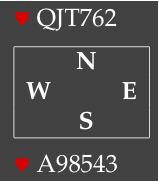 We once labelled a suit combination after him. I cannot remember the full hand, but the trump position was this, and the contract was 6♥. The side suits were solid and there were 13 tricks on top assuming you got the trumps right. That isn’t a problem, or is it? At the table, Peter led the ♥Q, saw the player on his right show out and... decided to duck as he thought he’d have a trump loser anyway. Lefty won, Peter claimed a couple of tricks later and at least nobody realized that they should have been in 7♥. In the bar after the match, we labelled this the “Verouden Coupe”: with 12 trumps missing the king, take a finesse. I’m not sure where Peter lives these days, but I’ll bet that he will still be explaining to somebody why it was right to finesse.
We once labelled a suit combination after him. I cannot remember the full hand, but the trump position was this, and the contract was 6♥. The side suits were solid and there were 13 tricks on top assuming you got the trumps right. That isn’t a problem, or is it? At the table, Peter led the ♥Q, saw the player on his right show out and... decided to duck as he thought he’d have a trump loser anyway. Lefty won, Peter claimed a couple of tricks later and at least nobody realized that they should have been in 7♥. In the bar after the match, we labelled this the “Verouden Coupe”: with 12 trumps missing the king, take a finesse. I’m not sure where Peter lives these days, but I’ll bet that he will still be explaining to somebody why it was right to finesse.
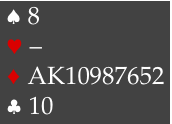 I had to think about this when reading about this hand during my vacation. All vulnerable, you pick up and hear 2NT (20-22 balanced) on your left, pass from partner, 3♥ (transfer) on your right. Your bid?
I had to think about this when reading about this hand during my vacation. All vulnerable, you pick up and hear 2NT (20-22 balanced) on your left, pass from partner, 3♥ (transfer) on your right. Your bid?
Well, the book on bidding 11 card suits still has to be written but a couple of things are clear. First, you have 11 tricks on top. Second, opener has a doubleton diamond, with voids for the two other players. Even if you end up on lead, you will not be able to give partner a ruff. Anyway, you have to bid and anything can be right. At the table, the player holding the hand tried 7♦. That puts maximum pressure on the opponents and will cost exactly 500. Much to your surprise, the auction now continues as follows. Partner leads the ♠J and declarer eventually finishes down 1, the full hand being this.
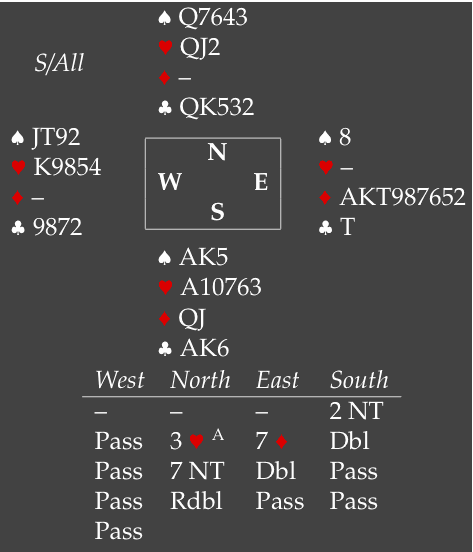 When asked about the 7NT bid, north says: partner showed 20-22 balanced, I have a 9 count and east must have 11 solid diamonds. That means that west has a diamond void and cannot lead one, and west can have, at most, the ♠J. That suggests 13 tricks. Nice try, but forgetting that 11 diamonds missing the ♦Q are as solid as 11 diamonds to the ♦AKQJ.
When asked about the 7NT bid, north says: partner showed 20-22 balanced, I have a 9 count and east must have 11 solid diamonds. That means that west has a diamond void and cannot lead one, and west can have, at most, the ♠J. That suggests 13 tricks. Nice try, but forgetting that 11 diamonds missing the ♦Q are as solid as 11 diamonds to the ♦AKQJ.
The hand is from a new book. “Top of Nul” (“Top or Bottom”) by Lukas Burgering. (Published in 2011 by Tirion Sport, ISBN 978 90 4390 068 3) Of course, the hand was shown as this, the author gave east 11 diamonds to the ♦AKQJ. I have no idea if the hand was actually dealt, but it look as if it was composed to make a point.
As you know, I just had a holiday for a couple of weeks and, as the schedule said that there would be a few quiet afternoons suitable for sitting in the sun with a beer and a book. Obviously, I went to my favorite bookstore and got a few recently published bridge books for my vacation. This one was one the stack but the book was quite disappointing. The hands were only moderately interesting, the stories around them lukewarm and there were quite a few errors in the analysis. The hand above is an example, but also this one.
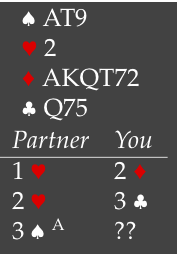 You are playing rubber bridge for money. After 2 hands, you have scored game and the opponents have a 60 part-score when you pick up this hands. The first bids are obvious and you have to decide what to do over 3♠.
You are playing rubber bridge for money. After 2 hands, you have scored game and the opponents have a 60 part-score when you pick up this hands. The first bids are obvious and you have to decide what to do over 3♠.
The author bid 6NT, which closed the auction. Is this a good bid? Time for a bit of math. If you simply bid game, you’ll no doubt make that with a couple of overtricks and win the rubber with about 900 points (2 games at 100 each, plus 700 for a rubber in 2). If you bid and make 6, you’ll win the rubber with about 1650 points. Of course, going down will cost you 100 points, plus that you give the opponents a chance to win the rubber on a next hand. Simple conclusion: slam in this situation should be much better than 70% and looking at the auction so-far, that is not going to be the case. It may be a lot less spectacular, but you should go for the sure profit.
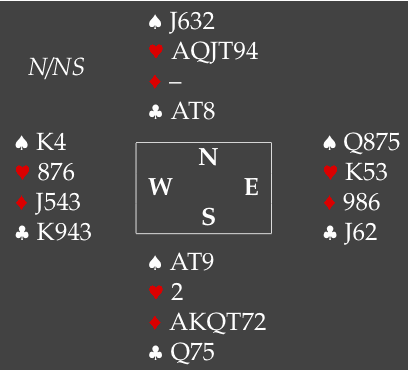 The full hand was this. The author describes how he made 6NT after a ♣3 lead, to the ♣8, ♣J, and ♣Q: a heart to the ♥J and when east ducked, the ♥A and ♥Q. Win the return and take the marked club finesse. Not really complicated, the hand sort of plays itself after the lead.
The full hand was this. The author describes how he made 6NT after a ♣3 lead, to the ♣8, ♣J, and ♣Q: a heart to the ♥J and when east ducked, the ♥A and ♥Q. Win the return and take the marked club finesse. Not really complicated, the hand sort of plays itself after the lead.
East apparently was not too happy about the lead, complaining that it was the only way to make the contract. While the club lead doesn’t look like the best lead for the defense, it is declarer’s second suit after all, east can still beat the contract by not sticking in the ♣J on the first round. This is actually something one can find, if west led from ♣Q943, it doesn’t matter which club you play, as either the ♣8 holds or declarer can take a finesse later, for a total of 3 club tricks. If west led from ♣K943, the ♣8 will win the trick but then declarer is left with ♣A10 opposite ♣Qx, with the ♣KJ still out, there is no way he can score a third club trick. Final flaw in the analysis: Tjap-Tjoi is not a chinese dish.
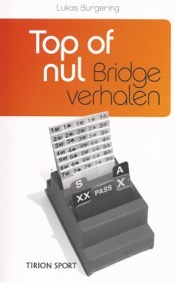 My conclusion about the book: hands that are not too interesting, stories that don’t add much, and lots of flaws in the analysis. If you want to take a bridge book with you on your vacation, get something else.
My conclusion about the book: hands that are not too interesting, stories that don’t add much, and lots of flaws in the analysis. If you want to take a bridge book with you on your vacation, get something else.
